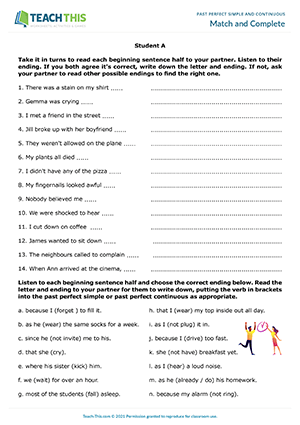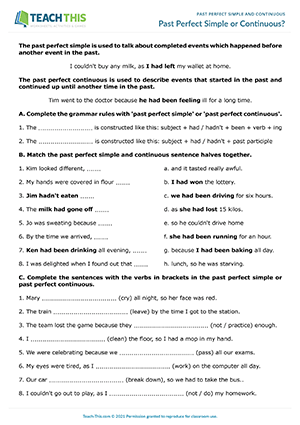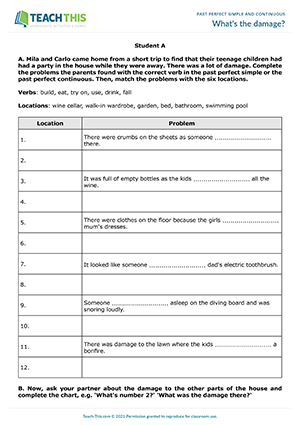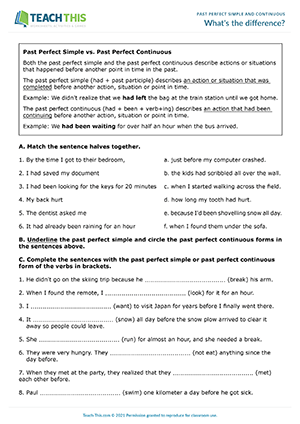In this fun past perfect simple or past perfect continuous game, students race to match sentence halves together and complete them using the past perfect simple or past perfect continuous. In pairs, students take turns reading each sentence beginning to their partner, who listens and chooses a suitable ending from their worksheet. Their partner then reads the letter and ending, putting the verb in brackets into the past perfect simple or past perfect continuous as appropriate. If both students agree it's correct, the other student writes down the letter and ending next to the sentence half on their worksheet, and they move on to the next sentence. If not, their partner reads other possible endings to find the right one. The first pair to finish and correctly match and complete all the sentences wins.
This free past perfect simple or past perfect continuous worksheet helps to teach students how these two tenses are different and how to use them. Students begin by reading sentences and completing rules about the past perfect simple and past perfect continuous. Next, students match past perfect simple and continuous sentence halves together. Students then complete sentences with verbs in brackets in the past perfect simple or past perfect continuous. After that, students complete each sentence with a verb from a box in its past perfect simple or past perfect continuous form. Students then complete sentences with their own ideas using the past perfect simple or past perfect continuous. Finally, in pairs, students play a miming game using the sentences. Students take turns reading the first part of the sentence and then miming the part they wrote. Their partner then tries to guess what they wrote from their mime. For each correct guess, students score one point. The student with the most points wins.
In this past perfect simple and past perfect continuous speaking activity, students complete a chart by matching issues caused by a party to locations in a house using the past perfect simple or past perfect continuous. Explain that Mila and Carlo came home to find that their teenage children had had a party in the house while they were away and that there was a lot of damage. Working alone, students complete issues the parents found with verbs in the past perfect simple or past perfect continuous tense. Students then match the issues with six locations in the house. Finally, students take turns asking a partner about the damage to the other parts of the house and completing a chart with their answers.
This insightful past perfect simple and past perfect continuous worksheet helps students review the differences between the two tenses. First, students match sentence halves together to form past perfect simple or past perfect continuous sentences. Students then underline the past perfect simple and circle the past perfect continuous forms in the sentences. Next, students complete sentences with the past perfect simple or past perfect continuous form of the verbs in brackets. After that, students answer questions using words in brackets in the past perfect simple or past perfect continuous tense. Finally, students complete sentences with their own ideas using the past perfect simple or continuous.
Latest Free
Resources
- Call and Respond
Business - Telephoning (B1)
Date Added: 24th of March
- Small Talk Techniques
Small Talk (B1)
Date Added: 20th of March
- Jigsaw Reading
Reading Exam Preparation (B1)
Date Added: 7th of March
- Writing Jeopardy
Writing Exam Preparation (B1)
Date Added: 6th of March
- Present Perfect Bingo
Present Perfect Yes No Questions (A2)
Date Added: 4th of March
Latest Member
Resources
- Please hold for a moment
Business - Telephoning (B2)
Date Added: 4th of April
- A Day out in Tokyo
Describing Places (A2)
Date Added: 1st of April
- Who Went Where?
Past Simple Wh Questions (A2)
Date Added: 1st of April
- Identifying Bias
Critical Thinking (B2)
Date Added: 31st of March
- Perfect Punctuation
Writing Exam Preparation (B1)
Date Added: 27th of March







